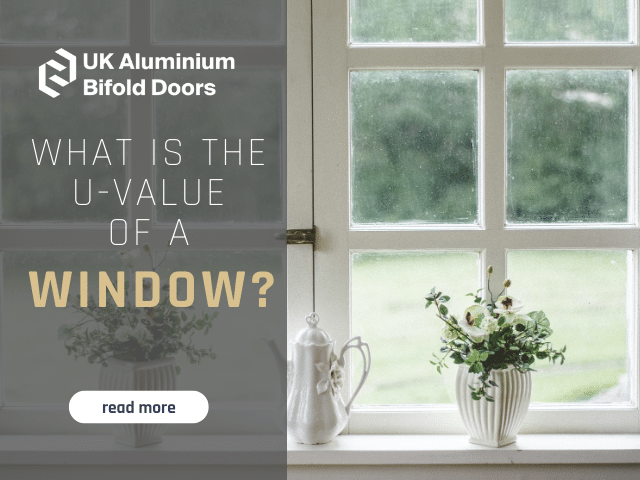Energy prices are rising. As a homeowner, you want to save as much money on your energy bills as possible while doing your bit for the environment.
Prioritising how energy efficient your windows are can help you achieve both. And you’ll be complying with building regulations in the process! This inevitably means conversations around the term U-value – the measure of a window’s glass thermal efficiency.
In the current economic climate, this is becoming an increasingly important consideration for homeowners across the UK, as a poorly insulated home will mean higher heating bills. Energy-efficient windows help keep your home at desirable temperatures by keeping the warm air in and the cold air out.
In this article, we’ll unpack what u-values mean and how they’re calculated, so you know how to determine the optimal U-value of your windows.
If you are ready to get thermal efficient aluminium fixtures, make sure to check out the aluminium doors we offer.
What Is A U-Value For Windows?
A U-value is a measurement of thermal efficiency. It’s an indication of heat loss and the rate at which it is lost. Simply put, it’s a determination of how quickly heat passes through glass. The lower the U-value, the more effective the insulation.
Windows and doors with a low U-value are ideal for houses and offices, as they keep warm air in during the winter months, keeping energy bills low.
The U-value is noted with a number that is followed by the letters W/m2k. What does this mean? The U-value is calculated as being the watts per square metre per Kelvin. If this sounds a bit complicated, don’t stress. There are a number of online U-value calculators that can crunch the numbers for you.
U-Values And Energy Ratings
The U-value on a window is similar to the energy rating you see on home appliances, rated from A (the lowest), up to G, (the highest). Some window performance figures are expressed as U-values and others as Window Energy Ratings (WER). U-values have become the more commonly used industry term.
Difference Between U-Value and Window Energy Rating
While the U-value tells you how well a window prevents heat loss, energy rating takes into account other factors like the window’s G-value and L-factor to give it an overall efficiency score.
G-value is a determination of how much heat will pass through a window, whereas the L-factor measures how airtight and draught-proof the window is. A window that isn’t very efficient against draughts may mean that you need to seal your aluminium window.
The higher the energy rating of a window, the more effective it will be.
How Are U-Values Calculated?
A formula is used to calculate the U-value (a measure of how well a building’s insulation works) and window energy rating (a measure of how much heat is lost through the windows).
This calculation estimates the energy balance of a typical UK house in a year, considering different window styles and configurations.
There are three key factors to consider when calculating a window’s U-value:
- Uf Value: The thermal performance of the frame
- Ug Value: The thermal performance of glass panels
- PSIG: The thermal performance of the glass edge
Combining these factors, the window’s opening mechanism and design, will give you the total U-value for your window.
What Is The Minimum U-Value For Windows?
When shopping for windows, you need to think about more than just the aesthetics or colour of the window and the type of aluminium window. You also need to consider the efficiency of the new windows.
All new or replacement windows (whether aluminium, PVCu or timber) must have a C Window Energy Rating or a minimum U-Value of 1.6W/m2K.
U-values for single-glazed windows
Single-glazed windows are not very well insulated. They have U-values around 5.8 W/m2K.
U-values for double-glazed windows
Double glazing is fast becoming the go-to window for replacements or new windows because it’s easier to source and more efficient than single-glazing units. The U-value for double-glazing windows is usually below 1.6 W/m2K.
U-values for triple-glazed windows
Triple-glazing is a new window-pane technology made up of three panes of glass. An extra pane of glass gives you energy efficient windows that improve thermal efficiency and minimise noise. The result is a U-value around 0.7 W/m2K, meaning this window energy rating is the best there is.
Check out our post on how to stop water leaking from aluminium windows to make sure your home stays as warm as possible during winter.
FINEO U-Value Windows
FINEO the new kid on the block. It is ultra-thin double glazing with better U-values than regular double glazing. Although, up to four times thinner than traditional triple-glazed windows, they perform just as well.
The frames of heritage-style windows are typically constructed with single glazing, which means that standard double-glazing glass won’t fit into the existing window frame. FINEO offers an environmentally friendly solution to spruce up heritage properties.
Building Regulations
In the UK, new and replacement windows must have a ‘C’ WER which indicates how well they keep out heat in the summer and cold in the winter. They also have to have a U-value that is no more than 1.6W/m²K, which shows how well they resist heat transfer.
For more about building regulations and installing doors and windows, head to our blog for aluminium doors tips and advice.
FAQs
Does the window frame affect U-value?
A window frame’s material can affect its energy efficiency. You should consider the difference in energy efficiency between metal, wood, and uPVC. Modern lightweight aluminium frames are far more energy-efficient..
You can see more on the cost of aluminium windows here, giving you a better idea of what you might be paying, but also how much money they can save you in the long run.
What is a ‘Passive House’?
Passive Houses are extremely energy efficient and environmentally friendly. These buildings leverage passive elements like sunshine and shading in place of central heating and air conditioning to keep the property warm and cool as required.
To meet Passive House standards, a new building must be super-tight and super-insulated. To pass the strict Passive House guidelines, a window’s U-value must be no higher than 0.80W/m²K.






